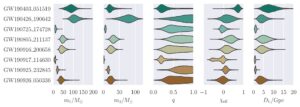Using new statistical techniques, the gravitational wave detectors of LIGO and Virgo have identified eight more suspected black hole collisions in existing measurement data. These include the heaviest pair of black holes ever observed.
LIGO/Virgo are publishing an update to the earlier catalog of observations with the detectors of oscillation caused by colliding objects (mostly black holes) in the cosmos. The list includes 1201 candidate events. Many signals have been added after criteria were relaxed, allowing for less certain events to be considered a real event.
Of these, 44 have an origin in the cosmos with more than 50 percent certainty. Of these, 36 had been published before and 8 are truly new. The measurements were made between April and October 2019, the so-called detector run O3b.

Most of the vibrational patterns in the new CWTC-2.1 list are presumably noise, which happens to resemble a gravitational wave that moved the mirrors of LIGO and Virgo. The reason the teams at LIGO and Virgo are publishing the fainter signals anyway is so that astronomers can use them to look for any luminous phenomena or sources of neutrinos.
Combinations of different observations, so-called multimessenger astronomy, are of extra interest to astrophysicists. In addition, the expanded list also gives a better idea of the number of pairs of black holes and collisions in the cosmos.
There are several interesting aspects to the new observations. One of the signals could have come from a collision of a neutron star with a black hole, given the details of the measurements.
Two signals seem to come from exceptionally heavy pairs of black holes. In one, a pair of combined 185 solar masses collided, resulting in a new black hole of 175 solar masses.
This is heavier than ever before observed, and falls into the so-called mass gap where astrophysicists do not expect black holes. Normally, black holes form when burned-up not-too-heavy stars explode.
How these specimens are formed remains to be seen. Possibly due to previous collisions of black holes. It may also be that the theory of star explosions is incorrect. The earlier catalog from 2020 already showed one pair with masses in the mass gap.
Furthermore, the new data found evidence that colliding black holes often exhibit the maximum internal rotation of their own, which theorists expect.
Nikhef is the Dutch partner in the LIGO/Virgo consortium and closely involved in the construction and measurements with the Virgo detector, and the analyses of the signals afterwards. Currently, the detectors are down for modifications and improvements. A new measurement campaign may begin next year.
